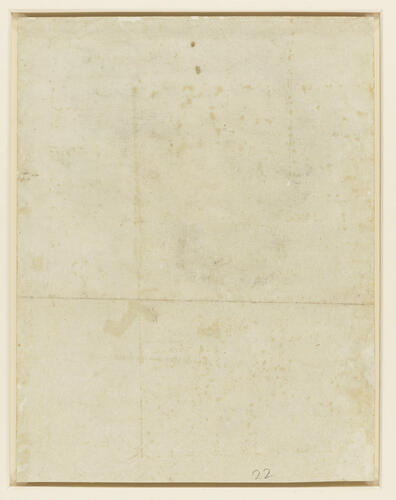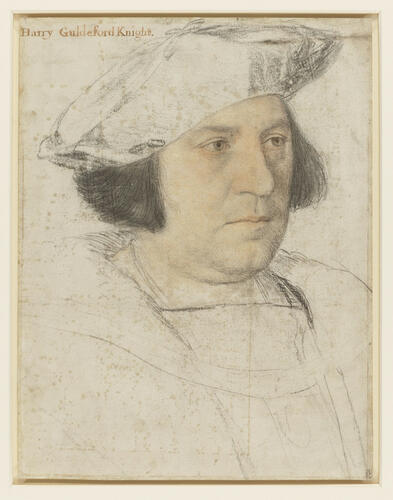-
1 of 253523 objects
Sir Henry Guildford (1489-1532) 1527
Black and coloured chalks with touches of brown ink | 38.3 x 29.4 cm (sheet of paper) | RCIN 912266

Hans Holbein the Younger (1497/8-1543)
Sir Henry Guildford (1489-1532) 1527


-
A portrait drawing of Sir Henry Guildford (1489-1532). A bust length portrait facing three-quarters to the right. He wears a hat and chain. A study for the painting in the Royal Collection (RCIN 400046). Inscribed in an eighteenth-century hand at upper left: Harry Guldeford Knight.
Sir Henry Guildford (1489-1532) was one of Henry VIII's closest friends. On the King's accession in 1509 he was appointed Esquire of the Body - a personal attendant on the King - and Master of Revels, responsible for organising the lavish entertainments at court. His parties included morris dancers, moving stages and a series of elaborate costumes for the young King. Guildford's influence at court was cut short in the 1519 purge of the so-called 'minions', an attempt by older statesmen to limit the influence of hot-headed young men on the 28-year-old monarch. Guildford soon returned to court, however, and developed a distinguished career as Comptroller of the Royal Household. In his continuing support for Katherine of Aragon he made a dangerous enemy of the King's mistress, Anne Boleyn, and it is a mark of his friendship with Henry that he remained in post until his death in 1532.
Guildford was a keen scholar as well as an experienced courtier, and his humanist interests may have drawn him to Hans Holbein (1497/8-1543) who arrived in England with a recommendation from Desiderius Erasmus. The two almost certainly worked together in the planning of revels at Greenwich in 1527, when a 'Master Hans' carried out much of the decorative painting. Guildford was one of the first in England to commission a portrait from Holbein; both the preparatory drawing and the finished oil painting survive.
This work, the preparatory drawing for the painting, demonstrates Holbein's versatility with chalk, which he has sharpened to create firm lines, blunted to give the contours of the hat, smudged to suggest the rich black of Guildford's hair and dampened to give a flesh-coloured tone to the face. A slight line of pen and ink has been used to sharpen the bottom right edge of Guildford's soft hat. The sheet has been cut down, but originally may have included the staff of office held in the sitter's right hand. The preparatory drawing for the portrait of Guildford's wife Mary, which survives in Basel, is on a much larger sheet (55.2 × 38.5 cm), and is probably closer to the original size of the present drawing.
The drawing is one of 11 by Holbein for which the final painted portrait survives. By laying tracings of Holbein drawings over the corresponding paintings, researchers have shown just how closely Holbein followed his preparatory sketches. This makes clear that, although today Holbein's drawings are valued and admired as works of art in their own right, for the artist they were tools for the production of a finished portrait. He appears to have used a variety of methods to transfer images from drawing to painting. While the portrait of Thomas More has been pricked around its contours to allow these to be transferred by means of dusted chalk, the outlines of the majority of surviving portrait drawings, including this example, appear to have been traced onto panels with metalpoint and a chalk-covered paper, which would leave chalk lines on the panel.
Catalogue entry adapted from The Northern Renaissance. Dürer to Holbein, London 2011Provenance
Henry VIII; Edward VI, 1547; Henry FitzAlan, 12th Earl of Arundel; by whom bequeathed to John, Lord Lumley, 1580; by whom probably bequeathed to Henry, Prince of Wales, 1609, and thus inherited by Prince Charles (later Charles I), 1612; by whom exchanged with Philip Herbert, 4th Earl of Pembroke, 1627/8; by whom given to Thomas Howard, 14th Earl of Arundel; acquired by Charles II by 1675
-
Creator(s)
Acquirer(s)
-
Medium and techniques
Black and coloured chalks with touches of brown ink
Measurements
38.3 x 29.4 cm (sheet of paper)
Markings
watermark: Briquet 1827,fleurs de lys in crowned shield [same as 12268 and 12272]
Object type(s)
Other number(s)
RL 12266